Imagine zooming along the Canadian highways when suddenly, your vehicle starts acting up – rough idling, poor acceleration, or decreased fuel efficiency. Sounds familiar? It might be due to a faulty fuel injection pressure regulator.
What is a Fuel Injection Pressure Regulator?
This essential device helps maintain the right amount of fuel pressure in your vehicle’s fuel injection system. When it functions correctly, it allows for smoother vehicle operation, better fuel efficiency, and reduced emissions.
How Much Will it Cost to Replace a Fuel Injection Pressure Regulator in Canada?
The cost of replacing a fuel injection pressure regulator in Canada can vary, but it typically ranges between $200 and $300. This includes parts, which are generally priced from $50 to $150, and labour, which can run from $150 to $200 depending on the mechanic’s hourly rate. Keep in mind, these prices are estimates and may fluctuate based on your location and the model of your vehicle.

What are the Symptoms of a Faulty Fuel Injection Pressure Regulator?
• Poor fuel efficiency: A faulty fuel injection pressure regulator may cause the engine to consume more fuel than usual. This can result in decreased fuel efficiency, requiring more frequent refueling or a noticeable decrease in mileage per gallon.
• Rough idling: If the fuel pressure is inconsistent or too low, the engine may experience rough idling. The vehicle may shake or vibrate while stationary, and the RPM (revolutions per minute) needle on the tachometer may fluctuate abnormally.
• Engine misfires: Insufficient fuel pressure caused by a faulty regulator can lead to engine misfires. Misfires occur when the air-fuel mixture ignites improperly or fails to ignite, resulting in a noticeable hesitation or jerking sensation while driving.
• Hard starting or difficulty in starting the engine: A defective fuel injection pressure regulator may cause problems during engine startup. The engine may require multiple attempts to start or take longer to start than usual.
• Strong fuel odor: A fuel injection pressure regulator that is stuck open or leaking can cause the fuel to overflow or leak into the engine or fuel system. This can result in a strong smell of fuel, both inside and outside the vehicle.
• Black smoke from the exhaust: Excessive fuel pressure caused by a malfunctioning regulator can lead to an overly rich air-fuel mixture. This can produce black smoke from the exhaust, indicating incomplete combustion.
• Loss of power and poor acceleration: Inadequate fuel pressure can result in reduced engine power and sluggish acceleration. The vehicle may struggle to reach higher speeds or respond promptly when the accelerator is pressed.
How Long Does a Fuel Injection Pressure Regulator Last?
Generally, a fuel injection pressure regulator is built to last for the life of the vehicle. However, like any mechanical part, it can fail prematurely due to wear and tear, contamination, or mechanical issues.
How Does a Fuel Injection Pressure Regulator Become Defective?
A fuel injection pressure regulator can become defective due to various factors, including:
• Wear and tear: Over time, the internal components of the fuel injection pressure regulator can wear out or become damaged. Constant exposure to fuel, heat, and pressure can lead to the deterioration of seals, diaphragms, or other critical parts within the regulator.
• Contamination: Contaminants, such as dirt, debris, or rust particles, can enter the fuel system and cause blockages or damage to the fuel injection pressure regulator. Contamination can affect the proper functioning of the regulator and lead to malfunctions.
• Fuel quality issues: Poor-quality or contaminated fuel can cause problems with the fuel injection pressure regulator. Impurities in the fuel can clog the regulator’s passages, impairing its ability to regulate fuel pressure effectively.
• Electrical or wiring issues: Some fuel injection pressure regulators have electrical components, such as solenoids or sensors, that can fail due to electrical issues or wiring problems. This can lead to incorrect fuel pressure regulation or complete failure of the regulator.
• Manufacturing defects: In rare cases, a fuel injection pressure regulator may have inherent manufacturing defects. These defects can include faulty materials, improper assembly, or design flaws that contribute to premature failure or malfunctions.

How Can a Faulty Fuel Injection Pressure Regulator Affect Engine Performance?
A faulty fuel injection pressure regulator can affect engine performance in the following ways:
• Inconsistent fuel pressure: A malfunctioning regulator may result in inconsistent fuel pressure, causing fuel delivery issues. This can lead to engine misfires, rough idling, and overall poor engine performance.
• Poor acceleration: Insufficient fuel pressure can hinder the engine’s ability to receive the optimal amount of fuel during acceleration, resulting in sluggish or delayed throttle response. This can make it difficult to achieve smooth and responsive acceleration.
• Reduced power output: Inadequate fuel pressure can impact the engine’s power output, leading to a noticeable decrease in overall performance. The engine may struggle to generate sufficient power for tasks such as climbing hills or overtaking vehicles.
• Difficulty starting the engine: A faulty fuel injection pressure regulator may cause fuel pressure to drop, making it harder to start the engine, particularly when the vehicle has been sitting for a while. This can result in prolonged cranking or multiple attempts to start the engine.
• Stalling or engine hesitation: Fluctuating fuel pressure due to a faulty regulator can cause intermittent stalling or hesitation while driving. The engine may exhibit a loss of power or momentarily hesitate, impacting the overall smoothness of the driving experience.
Is it Safe to Drive with a Faulty Fuel Injection Pressure Regulator?
Driving with a faulty fuel injection pressure regulator can be unsafe and may lead to various issues with your vehicle’s performance. The fuel injection pressure regulator is responsible for maintaining the proper fuel pressure in the fuel system. When the regulator malfunctions, it can result in inconsistent fuel pressure, which can cause a range of problems. Insufficient fuel pressure may lead to poor engine performance, reduced power, and difficulty starting the vehicle. On the other hand, excessive fuel pressure can cause fuel leaks, fuel system damage, or even engine flooding. These issues can compromise the overall drivability and safety of your vehicle, especially during critical situations that require quick acceleration or precise engine response.
Additionally, a faulty fuel injection pressure regulator can impact fuel efficiency and emissions. Inadequate fuel pressure can result in an inefficient fuel-air mixture, leading to decreased fuel economy and increased emissions. This can not only lead to higher fuel costs but also contribute to environmental pollution. Furthermore, a malfunctioning regulator can cause fuel to leak into the engine or other parts of the fuel system, posing a potential fire hazard. It is important to address any signs of a faulty fuel injection pressure regulator promptly and have it repaired or replaced by a qualified technician to ensure the safe operation of your vehicle, optimize fuel efficiency, and minimize environmental impact.
How Can I Make My Fuel Injection Pressure Regulator Last Longer?
• Regularly service your vehicle
• Use high-quality fuel
• Have your fuel system professionally cleaned periodically
• Replace the fuel filter as recommended by the vehicle manufacturer
Can a Mobile Mechanic Replace a Fuel Injection Pressure Regulator?
Yes, a mobile mechanic has the necessary tools and skills to replace a fuel injection pressure regulator. Mobile mechanics can be an excellent choice for this type of job as they can come to your location, saving you time and hassle.

Conclusion: Fuel Injection Pressure Regulator Replacement
In conclusion, maintaining the health of your fuel injection pressure regulator is crucial for your vehicle’s optimal performance and your safety on the road. Be aware of the symptoms of a faulty regulator, and if you suspect a problem, seek professional help immediately. Regular vehicle maintenance and the use of high-quality fuel can go a long way in prolonging the life of your fuel injection pressure regulator.
Next Steps
Book Your Fuel Injection Pressure Regulator Replacement Service
The service most frequently booked by those who read this article is Fuel Injection Pressure Regulator Replacement. Uchanics’ expert technicians make the process even more convenient by bringing the service right to your doorstep. We perform this job at your home or office, covering over 40 cities in Ontario, including Oshawa, Ajax, Toronto, Scarborough, Mississauga, Brampton, and more. Our commitment to excellence has earned us more than 700 glowing 5-star reviews. Choose Uchanics for your Fuel Injection Pressure Regulator Replacement and experience unparalleled convenience and top-quality service.
